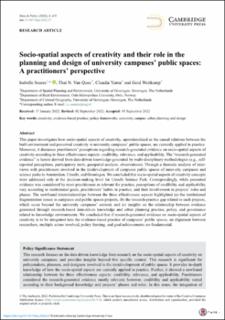Socio-spatial aspects of creativity and their role in the planning and design of university campuses`public spaces: A practitioners`perspective
Peer reviewed, Journal article
Published version
Permanent lenke
https://hdl.handle.net/11250/3053969Utgivelsesdato
2022Metadata
Vis full innførselSamlinger
Originalversjon
https://doi.org/10.1017/dap.2022.27Sammendrag
This paper investigates how socio-spatial aspects of creativity, operationalized as the causal relations between the built environment and perceived creativity in university campuses’ public spaces, are currently applied in practice. Moreover, it discusses practitioners’ perceptions regarding research-generated evidence on socio-spatial aspects of creativity according to three effectiveness aspects: credibility, relevance, and applicability. The “research-generated evidence” is herein derived from data-driven knowledge generated by multi-disciplinary methodologies (e.g., self-reported perceptions, participatory tools, geospatial analysis, observations). Through a thematic analysis of interviews with practitioners involved in the (re)development of campuses public spaces of inner-city campuses and science parks in Amsterdam, Utrecht, and Groningen. We concluded that socio-spatial aspects of creativity concepts were addressed only at the decision-making level for Utrecht Science Park. Correspondingly, while presented evidence was considered by most practitioners as relevant for practice, perceptions of credibility and applicability vary according to institutional goals, practitioners’ habits in practice, and their involvement in projects’ roles and phases. The newfound interrelationships between the three effectiveness aspects highlighted (a) the institutional fragmentation issues in campuses and public spaces projects, (b) the research-practice gap related to such projects, which occur beyond the university campuses’ context, and (c) insights on the relationship between evidence generated through research-based data-driven knowledge and urban planning practice, policy, and governance related to knowledge environments. We concluded that if research-generated evidence on socio-spatial aspects of creativity is to be integrated into the evidence-based practice of campuses’ public spaces, an alignment between researchers, multiple actors involved, policy framing, and goal achievements are fundamental.

